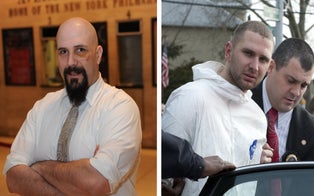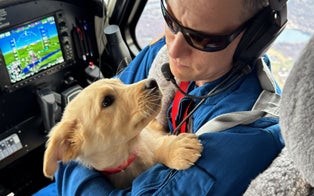Near-death experiences are something that thousands of people have claimed to have. Jessie Sawyer and Betty J. Eadie both said their spiritual experiences altered their lives forever.
When Jessie Sawyer went to the hospital for a routine hysterectomy, she never imagined she would die. Sawyer is one of the many who have claimed to have had a near-death experience, or an NDE, and she said hers changed her life forever.
“If anybody had told me 10 years ago that I would have had a near-death experience, I would not have believed them,” Sawyer told Inside Edition Digital. “I didn't believe in these things. I didn't even believe in God anymore.”
Nine months before her experience, Sawyer, who lives in Tennessee, said she had been going to different doctors because she was having gynecological problems and eventually it was recommended that she have a hysterectomy. In May 2013 at the age of 30, she underwent the surgery, which went well. She said doctors didn’t find anything wrong, but when she returned home from the hospital, things took a turn for the worse. Sawyer said she began experiencing intense stomach pain and asked her husband to take her to the hospital immediately.
When she arrived at the hospital, she knew the situation was serious.
“My heart rate was 145. I was running a low grade fever, and they did some scans and found out that I was bleeding internally. And I also had something called a paralytic ileus, which basically just means my intestines had stopped moving,” Sawyer said.
She didn’t have enough blood in her body to undergo another surgery to find out what was wrong and doctors had already begun blood transfusions. Then, one night in the hospital, Sawyer said something unimaginable happened.
“I'm staring at the wall, and it was like... The best way I can describe it is that my eyes opened, and then they opened again. And when they opened again, I was in this endless misty white room,” Sawyer said. “It was just this space. And the very first thing that I realized was that I was able to stand up straight, which is something that I hadn't been able to do since the surgery.”
Sawyer said she noticed her friend Anthony, who had already passed away. She at first was excited to see him, but quickly realized that this wasn’t a reunion. She had died.
“This was my death. And Anthony was there to take me home,” Sawyer said. “The light started off as this shimmer, and then it grew. I mean, maybe it was 15 feet away from me. I don't really know because the light itself is limitless. It's timeless….There’s no way you can describe it. It is the most profound, most unconditional love.”
Dr. Jeffrey Long, founder of the Near-Death Experience Research Foundation, started his research on near-death experiences 20 years ago, and said they’re way more common across the world than he thought. Long, who works in radiation oncology in Louisiana, said there’s numerous similarities in the NDEs he’s documented over the years. The experiences often include a life-threatening event, an “out of body” experience, a tunnel, a brilliant white light and an overwhelming feeling of positive emotions. Many have claimed they reunited with loved ones and pets in those moments.
“And then at the end of the experience, there's often a choice about whether to stay in that beautiful realm or to return to their earthly life,” Long said. “When that decision is ultimately made and they return to earthly life and they recover from that close brush with death, then they can share their near-death experience.”
Betty J. Eadie, 78, author of the best-seller “Embraced by the Light,” can attest to those things being true for her NDE. After a routine hysterectomy at 31 years old, Eadie documents in her book how she died in the hospital and went through a tunnel to a "beautiful" realm where she met Jesus. She said she was thoroughly disappointed when she realized she would have to return.
“I recognized God and I ran to him and fell at his feet, my head on his lap,” Eadie recalled. “And he said, "You have a mission to perform. And I want you to see what that mission entails. Then you must go back.”
Eadie described that when she did return, she struggled to adjust back to regular life.
“I came back. I was not very happy about being back,” Eadie said. “My husband was very uncomfortable. He heard me and he listened, but he was very uncomfortable. He was a Southern Baptist. And so this was just way out of his spiritual upbringing.”
Eadie, who lives in Washington, said she found solace in speaking at churches about her experience and serving others.
“The adjustments made after a near-death experience can be difficult and slow,” Long said. “Even though they have profound insights by their own personal experience, that there's life after death, a wonderful life beyond death that they believe is for all of us, it's still a slow adjustment. They have their patterns of behavior, they have those relationship patterns that have been developed over the years.”
Scientists over the years can only speculate what is occurring when someone experiences a near-death experience. Studies have found that people have had similar experiences when they're under the influence of psychoactive substances like psilocybin, LSD and DMT. A study in the Journal of the Missouri State Medical Association in 2015 hypothesized that the experiences could be caused by a type of "borderland consciousness."
"A borderland [is] when the conscious states of waking and rapid eye movement (REM) blend, forming a hybrid conscious state. REM consciousness is named for the saccadic eye movements that accompany the robust visual system activation characterizing this conscious state," the study reads.
Despite the studies that have been done, it remains that no one really knows what causes near-death experiences.
Sawyer said when she did return to her body after her near-death experience, she started quickly getting better. Her doctor would later tell her she wasn’t doing well there for a while and death could have been possible.
“Going back into my body hurt,” Sawyer said. “It was like jumping into an ice cold pool after being in a sauna. It was maybe 12 hours after that event happened, but I suddenly started expelling all the blood that had been pooling in my abdominal cavity. I expelled over two liters of blood and 800 CC's of fist-sized clots.”
She said she's a different person now, and she's studying to become a mental health counselor for those struggling with loss and grief.
“When I started to kind of rejoin the world, I felt this intense love for everyone,” Sawyer said. And not that I was necessarily a selfish person beforehand, but you only really care about the people that you know. This new feeling was that I cared about everybody I saw, just the connection that I felt to everything... To wind, to sound, to plants, to animals, to humans, it was intensified.”
Both Eadie and Sawyer also have another thing in common now: They have no fear of death.
“I want to go back,” Eadie said.
RELATED STORIES





